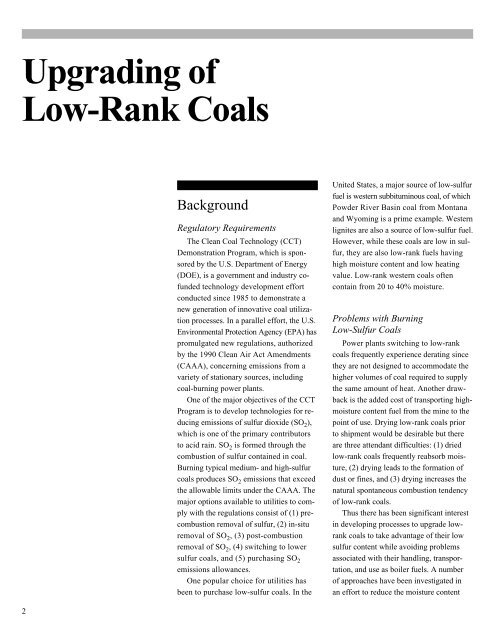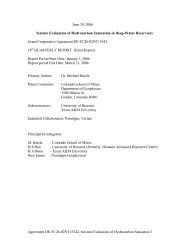Upgrading of Low-Rank Coals - National Energy Technology ...
Upgrading of Low-Rank Coals - National Energy Technology ...
Upgrading of Low-Rank Coals - National Energy Technology ...
You also want an ePaper? Increase the reach of your titles
YUMPU automatically turns print PDFs into web optimized ePapers that Google loves.
<strong>Upgrading</strong> <strong>of</strong><br />
<strong>Low</strong>-<strong>Rank</strong> <strong>Coals</strong><br />
2<br />
Background<br />
Regulatory Requirements<br />
The Clean Coal <strong>Technology</strong> (CCT)<br />
Demonstration Program, which is sponsored<br />
by the U.S. Department <strong>of</strong> <strong>Energy</strong><br />
(DOE), is a government and industry c<strong>of</strong>unded<br />
technology development effort<br />
conducted since 1985 to demonstrate a<br />
new generation <strong>of</strong> innovative coal utilization<br />
processes. In a parallel effort, the U.S.<br />
Environmental Protection Agency (EPA) has<br />
promulgated new regulations, authorized<br />
by the 1990 Clean Air Act Amendments<br />
(CAAA), concerning emissions from a<br />
variety <strong>of</strong> stationary sources, including<br />
coal-burning power plants.<br />
One <strong>of</strong> the major objectives <strong>of</strong> the CCT<br />
Program is to develop technologies for reducing<br />
emissions <strong>of</strong> sulfur dioxide (SO2 ),<br />
which is one <strong>of</strong> the primary contributors<br />
to acid rain. SO2 is formed through the<br />
combustion <strong>of</strong> sulfur contained in coal.<br />
Burning typical medium- and high-sulfur<br />
coals produces SO2 emissions that exceed<br />
the allowable limits under the CAAA. The<br />
major options available to utilities to comply<br />
with the regulations consist <strong>of</strong> (1) precombustion<br />
removal <strong>of</strong> sulfur, (2) in-situ<br />
removal <strong>of</strong> SO2 , (3) post-combustion<br />
removal <strong>of</strong> SO2 , (4) switching to lower<br />
sulfur coals, and (5) purchasing SO2 emissions allowances.<br />
One popular choice for utilities has<br />
been to purchase low-sulfur coals. In the<br />
United States, a major source <strong>of</strong> low-sulfur<br />
fuel is western subbituminous coal, <strong>of</strong> which<br />
Powder River Basin coal from Montana<br />
and Wyoming is a prime example. Western<br />
lignites are also a source <strong>of</strong> low-sulfur fuel.<br />
However, while these coals are low in sulfur,<br />
they are also low-rank fuels having<br />
high moisture content and low heating<br />
value. <strong>Low</strong>-rank western coals <strong>of</strong>ten<br />
contain from 20 to 40% moisture.<br />
Problems with Burning<br />
<strong>Low</strong>-Sulfur <strong>Coals</strong><br />
Power plants switching to low-rank<br />
coals frequently experience derating since<br />
they are not designed to accommodate the<br />
higher volumes <strong>of</strong> coal required to supply<br />
the same amount <strong>of</strong> heat. Another drawback<br />
is the added cost <strong>of</strong> transporting highmoisture<br />
content fuel from the mine to the<br />
point <strong>of</strong> use. Drying low-rank coals prior<br />
to shipment would be desirable but there<br />
are three attendant difficulties: (1) dried<br />
low-rank coals frequently reabsorb moisture,<br />
(2) drying leads to the formation <strong>of</strong><br />
dust or fines, and (3) drying increases the<br />
natural spontaneous combustion tendency<br />
<strong>of</strong> low-rank coals.<br />
Thus there has been significant interest<br />
in developing processes to upgrade lowrank<br />
coals to take advantage <strong>of</strong> their low<br />
sulfur content while avoiding problems<br />
associated with their handling, transportation,<br />
and use as boiler fuels. A number<br />
<strong>of</strong> approaches have been investigated in<br />
an effort to reduce the moisture content

















